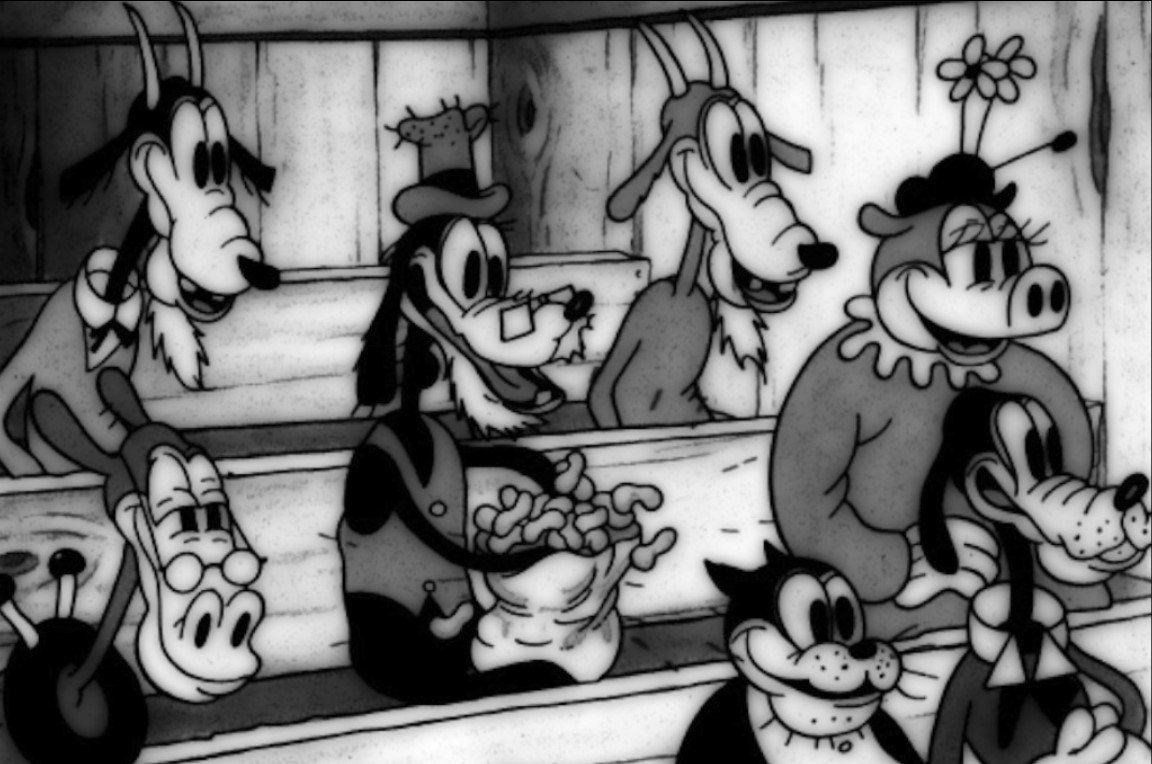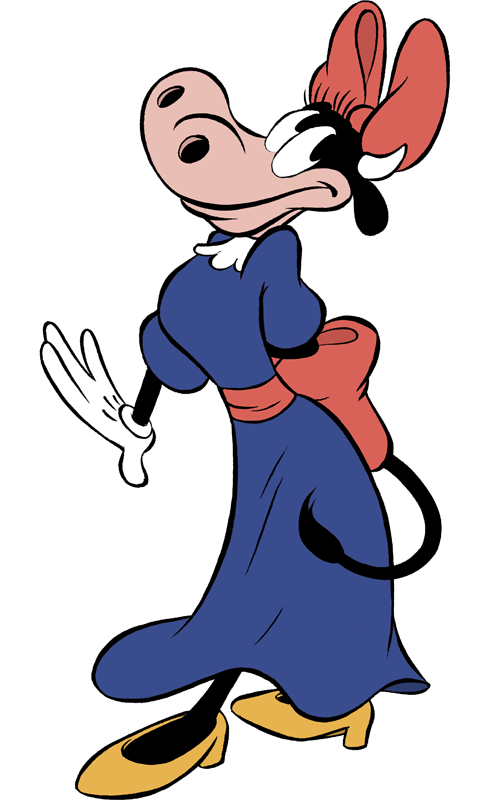The Relationship Evolution of Goofy and Clarabelle Cow
For the last 2 years around Valentines Day, I’ve covered 2 of the most famous cartoon couples ever: Mickey and Minnie Mouse, and Donald and Daisy Duck. These characters have been around since the beginning of the Walt Disney Company, with Donald and Daisy starting to make appearances in the 1930s and 1940s. Another one of the original Fab Five, Goofy, joined the gang around the same time as Donald Duck. Goofy’s love interest, Clarabelle Cow, had a prominent role within the group at the beginning, but then slowly faded into the background as Disney’s animated films began to be more popular than their cartoons. Let’s take a look at the legacy and partnership of Goofy and Clarabelle Cow over the last 60 years.
Clarabelle Cow and Goofy in Hong Kong Disneyland. Image from: https://twitter.com/360DegreesofDis/status/1362826421719228419/photo/1
Goofy’s first appearance
Goofy was first introduced as Dippy Dawg in Mickey’s Revue on May 27th, 1932. Dippy Dawg was first shown as an older anthropomorphic canine with a beard and glasses. Though he didn’t look exactly like what Goofy’s later iteration looked like, it was clear they were meant to be the same character through the similarities in the laugh. The plot of Mickey’s Revue was that Dippy Dawg was disturbing the audience from Mickey’s performance because of his laughing and loud crunching of peanuts. Pinto Colvig provided the laugh for Dippy Dawg and for Goofy later on. His name was officially changed in the short Orphan’s Benefit on August 11th, 1934. This is when he became a staple character in the shorts along with Donald Duck.
Dippy Dawg in Mickey’s Revue. Image from: https://mickeyblog.com/2022/05/25/happy-birthday-goofy/
clarabelle cow’s first appearance
When Disney and Ub Iwerks were developing their anthropomorphic animal characters, a cow was slid across the idea table a few times, as evident in Mickey’s very first cartoon, Plane Crazy in May 1928. A cow is seen being chased after Mickey’s plane as he pilots it in a chaotic way. A cow appears again the following year in The Plowboy, who is seen dancing with Minnie. This short contrasts between Mickey and Horace Horsecollar and Minnie and the cow. This is the closest we get as a first unofficial appearance by Clarabelle before she is named and officially becomes a reoccurring character. Her name would come from a comic strip called Mickey Mouse in Death Valley on April 2, 1930.
“Oh, Minnie, here comes Clarabelle Cow, the town gossip. I heard she had her tonsils removed so she could talk more freely!”
Clarabelle’s first official cartoon appearance is in the 1930 short The Shindig. Mickey and Minnie are holding a concert for all their friends, so Horace Horsecollar goes to Clarabelle’s to pick her up. Clarabelle slips on her skirt, puts her makeup powder on, places her hat on her head, then struts out to join Horace on his bike. She later shares a dance with Horace and Mickey, not yet being an established love interest of Goofy. During the early years, she was shown as the girlfriend of Horace Horsecollar, and occasionally the two were paired together in later years as well. In an attempt to continue the narrative that Clarabelle was a gossip, she mostly hung around with Minnie and Daisy as one of their close friends.
Clarabelle Cow in The Shindig. Image from: https://animationfan69.tumblr.com/post/166414844199/the-disney-elite-clarabelle-cow-in-the
the evolution of goofy and clarabelle
Goofy’s PHYSICAL appearance
As mentioned above, Goofy as Dippy Dawg lasted only a short lifetime, through Mickey’s Revue and The Whoopee Party in 1932. In Orphan’s Benefit in 1934, Goofy performs a dance with Horace Horsecollar and Clarabelle Cow, which is the second time we see Goofy and Clarabelle interact. Goofy now sports his signature hat, this time blue, a large green shirt, floppy shoes, and a brown and black spotted torn cloth around him. It’s not until 1935 in the short On Ice that Goofy begins to solidify his appearance, donning his blue pants, eyes beginning to droop, and shoes flattening.
Horace Horsecollar, Clarabelle Cow and Goofy in Orphan’s Benefit. Image from: https://m.imdb.com/title/tt0025609/mediaviewer/rm1486445056
Through the early 1940s, the saturation on the shorts was turned up, and the colours used for his outfits changed every once in a while. The number of fingers he had, as well as the showing of his ears was inconsistent for a number of years. In the short Tennis Racquet, it shows the animators were attempting an experimental change of looks for him, shrinking his eyes and changing his skin from black to brown. That only lasted for one cartoon though, as by the next one, he was back to his original design. There was also a period in the early 1950s that Goofy had larger, rounder eyes and his buck teeth were moved closer together. That was also short lived, as his buck teeth went back to the far sides of his mouth and pupils moved closer together. His signature blue pants, orange shirt and green hat combination was introduced in Mickey Mouse Works in 1999, and solidified through the creation of Mickey Mouse Clubhouse in 2006.
Goofy starred in 96 Disney projects from the 1930s to the 2000s, and has continued to be a staple mascot for the Disney company.
Goofy in Tennis Racquet. Image from: https://www.youtube.com/watch?v=6G-k9JQ6n0o
Goofy in Mickey Mouse Clubhouse. Image from: https://www.wallpapers13.com/goofys-super-wish-mickey-mouse-clubhouse-episode-hd-wallpapers-1920x1080/
clarabelle’s physical appearance
In the comic strip Mickey Mouse and the Death Valley, Clarabelle is seen wearing a hat with a flower in it, similar to Minnie’s old hat, gloves, a skirt, high heels, and her signature cow bell around her neck. In The Barnyard Concert in 1930, Clarabelle begins to take on humanoid traits like Minnie, where eyelashes and eyeshadow are added to her appearance. She continues to sport her skirt and hat combo, while occasionally wearing full body clothing, like in The Beach Party (1931) and Orphan’s Benefit (1934) when she wears a full dress.
Mickey, Minnie, Clarabelle and Horace in Mickey Mouse and the Death Valley. Image from: https://www.flickr.com/photos/fantagraphics/5689641994/
In the 1941 remake of Orphan’s Benefit in colour, animators added a Minnie-like bow to Clarabelle, and ballet flats. Her facial features evolved with the changes in animation becoming more “realistic”. The following year, her full dress and bow outfit would become her staple look.
Clarabelle Cow. Image from: https://www.chroniquedisney.fr/perso/1929-clarabelle-cow.htm
goofy and clarabelle’s relationship
Aside from their interaction in Orphan’s Benefit, they are also seen flirting in the 1935 short The Band Concert, as Clarabelle plays the flute and Goofy plays the trumpet. However, despite these early introductions to audiences that are seemingly setting up the relationship, Clarabelle’s popularity drops off massively in the 1940s. She stars in only 4 cartoons that decade, and doesn’t appear again on screen for another 40 years. Her spirit is kept alive through the comic strips, as she appears alongside Goofy in the 1965 comic Super Goof, introduced as his girlfriend. This only lasts until 1969, when Goofy receives a new partner, Glory Bee. Through the 1970s, Clarabelle reverts back to her relationship with Horace in a few select projects.
After An Extremely Goofy Movie in 2000, Goofy returns to his original love interest. In 2002, Clarabelle makes a cameo in an episode of House of Mouse called Super Goof, which seems to be a call back to the comic. Goofy falls for Clarabelle in this episode, and the partnership is put on more of an official pedestal in the 2004 direct-to-video movie The Three Musketeers. For the next decade, Goofy and Clarabelle would be seen together, especially in Mickey Mouse Clubhouse episodes. Their romantic partnership would never be as stable or consistent as Mickey and Minnie or Donald and Daisy’s though.
Goofy and Clarabelle in The Band Concert. Image from: https://www.flickr.com/photos/mgmcinnis/135467958
Clarabelle and Goofy in Mickey Mouse Clubhouse. Image from: https://www.watchconlines.com/2015/04/felicita-sung-by-goofy-and-clarabelle.html
honourable mention: horace horsecollar
Clarabelle Cow and Horace Horsecollar in On Ice. Image from: https://danikawatches.tumblr.com/post/189729094218/disney-shorts
Horace has been referred to a few times throughout this article, and that’s because he was the main love interest for Clarabelle from the beginning, and has returned several times throughout the years when she wasn’t depicted with Goofy. He was often her counterpart for double dates with Mickey and Minnie in a handful of shorts. In the comic Clarabelle’s Boarding House, Horace even proposes to her, confirming the partnership. When Clarabelle’s popularity fell off, so did Horace’s, and he is seen again only a handful of times for the latter half of the 20th century. He makes an appearance in the series Mickey and the Roadstar Racers, where Clarabelle is seen swooning over Horace as a racecar driver.
“Looks like Horace is trying to propose to Clarabelle at last - and it’s up to me to see that he goes through with it.”
Reference list:
https://www.youtube.com/watch?v=5sU5rBQV2bM
https://www.youtube.com/watch?v=kCZPzHg0h80
https://www.youtube.com/watch?v=G1sM-XrrsJA
https://loveinterest.fandom.com/wiki/Clarabelle_Cow
https://www.youtube.com/watch?v=7DBKROmNfxc
https://disney.fandom.com/wiki/Goofy_Through_the_Years
https://disney.fandom.com/wiki/Goofy/Filmography
https://goofy.fandom.com/wiki/Orphan%27s_Benefit
https://www.youtube.com/watch?v=rIVbiTbqAwg













